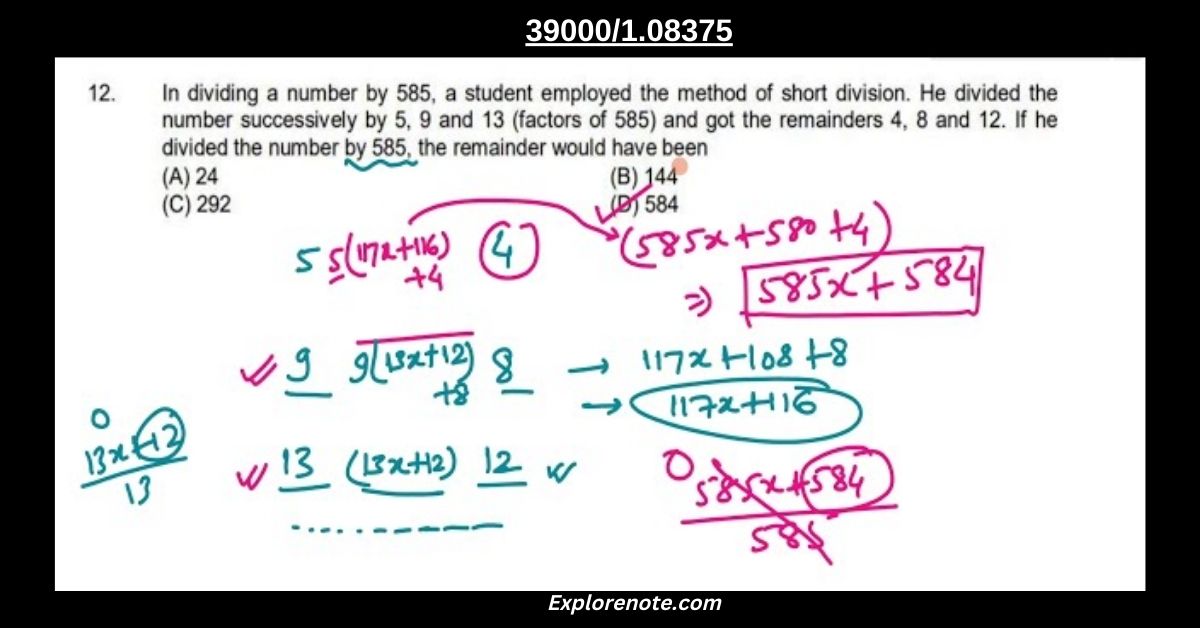Have you ever come across the mathematical expression 39000/1.08375 and wondered about its meaning or application?
This calculation might seem simple at first glance, but it has practical implications in various areas like finance, business, engineering, and everyday problem-solving.
In this article, we will explore what 39000/1.08375 means, where it can be used, and why it is significant.
By the end of this comprehensive guide, you will have a clear understanding of the expression and its relevance in real-life situations.
Whether you are calculating financial figures or solving engineering problems, this article will equip you with insights that go beyond the basics.
What Does 39000/1.08375 Mean?
In its simplest form, 39000/1.08375 is a division problem. When you divide 39,000 by 1.08375, you get approximately 35,976.36. This result can represent various things, depending on the context:
- A financial calculation to adjust for inflation or interest rates.
- A conversion factor in scientific or engineering measurements.
- A practical computation in business for pricing or cost analysis.
Understanding the context is key to interpreting this number correctly.
Applications of 39000/1.08375
1. Financial Calculations
One of the most common uses of 39000/1.08375 is in financial calculations, such as:
- Adjusting for Inflation:
If 1.08375 represents an inflation rate, dividing 39,000 by this number gives the value of 39,000 in terms of a previous year’s dollars. For example:- 39000 (current value) / 1.08375 (inflation rate) = 35,976.36 (adjusted value)
This means the equivalent value of 39,000, accounting for 8.375% inflation, would be around 35,976.36.
- 39000 (current value) / 1.08375 (inflation rate) = 35,976.36 (adjusted value)
- Loan Repayments:
If 1.08375 is an interest multiplier, this calculation could represent the principal amount of a loan after accounting for the interest.
2. Business Pricing and Cost Analysis
In business, accurate pricing and cost analysis are essential. Here’s how 39000/1.08375 might come into play:
- Discounted Pricing:
Suppose a company wants to apply a discount represented by the factor 1.08375 to a price of 39,000. The result of the division (35,976.36) would represent the discounted price. - Cost Reduction Analysis:
Businesses often calculate costs relative to efficiency metrics. Dividing a total cost by a factor such as 1.08375 might indicate cost adjustments due to improved efficiency.
3. Engineering and Scientific Use Cases
In technical fields, numbers like 1.08375 often represent ratios, coefficients, or scaling factors. 39000/1.08375 could be used in:
- Material Strength Calculations:
Engineers may divide a total load (39,000 units) by a safety factor (1.08375) to determine the maximum allowable stress. - Conversion Metrics:
This calculation might convert one set of units to another, such as from metric to imperial systems.
4. Everyday Use
In daily life, 39000/1.08375 might appear in:
- Budget Adjustments:
If you’re budgeting 39,000 for a project but need to adjust for a 1.08375 rate of inflation, dividing gives you the value you should aim for to stay within budget. - Shopping Discounts:
Calculating discounts and sales often involves dividing prices by discount factors. For example, if an item priced at 39,000 is on sale with a 1.08375 adjustment, the sale price would be around 35,976.36.
Step-by-Step Calculation of 39000/1.08375
Performing the calculation 39000/1.08375 is simple if you follow these steps systematically. Whether you’re doing it manually, using a calculator, or solving it digitally, here’s how to proceed:
Step 1: Write Down the Expression
Start with the equation as written:
39000 \div 1.08375
39000÷1.08375
This represents the process of dividing 39,000 by 1.08375.
Step 2: Understand the Numbers
- 39,000: This is the dividend (the number being divided). It might represent a financial amount, a quantity, or a total value.
- 1.08375: This is the divisor (the number by which you divide). It often represents a multiplier, such as an interest rate, inflation adjustment, or efficiency ratio.
Step 3: Perform the Division
Use a calculator or manual long division to find the result.
- On a Calculator:
- Enter 39,000.
- Press the division symbol (÷ or /).
- Enter 1.08375.
- Press = to calculate the result.
- The result is approximately 35,976.36.
- Manually (Optional):
If you’re solving this manually, divide 39,000 by 1.08375 using long division. It’s tedious but follows the same principle.
Step 4: Verify the Result
To ensure accuracy, multiply the result by the divisor:
35,976.36 \times 1.08375 = 39,000
35,976.36×1.08375=39,000
If the product equals the original dividend (39,000), the calculation is correct.
Step 5: Interpret the Result
The result, 35,976.36, can have various interpretations depending on the context:
- Financial Context: It might represent the original value of 39,000 adjusted for an inflation or interest rate of 1.08375.
- Business Context: It could indicate a discounted price or reduced cost.
- Engineering Context: It might reflect a scaled-down value based on a safety or efficiency factor.
Why Is This Calculation Important?
1. Precision Matters
In finance, business, and engineering, precise calculations are crucial. Small errors can lead to significant discrepancies.
2. Real-World Relevance
Understanding expressions like 39000/1.08375 enables better decision-making, from financial planning to technical problem-solving.
3. Improved Understanding
Breaking down complex numbers into meaningful results improves comprehension and confidence in handling similar problems.
Related Calculations
Here are some related calculations that might help in different contexts:
- 39000 × 1.08375 = 42,266.25 (Inflating instead of deflating the value)
- 39000 – 35,976.36 = 4,023.64 (Difference or adjustment amount)
- 35,976.36 ÷ 39000 = 0.92258 (Ratio of adjusted to original value)
These variations illustrate how the same numbers can provide insights from different perspectives.
FAQs about 39000/1.08375
Q1: What is the result of 39000/1.08375?
The result is approximately 35,976.36.
Q2: Where is this calculation used?
This calculation is commonly used in finance (adjusting for inflation or interest), business (pricing and cost analysis), and engineering (safety factors and conversions).
Q3: Why is 1.08375 important?
The number 1.08375 often represents a multiplier or adjustment factor, such as inflation, interest, or a scaling ratio.
Q4: How do I verify the result of 39000/1.08375?
Multiply the result (35,976.36) by 1.08375. If the product equals 39,000, the calculation is correct.
Q5: Can this calculation be applied to personal finances?
Yes, it can help in budgeting, adjusting for inflation, or calculating discounts.
Conclusion
The calculation 39000/1.08375 might seem simple, but its applications span across finance, business, engineering, and everyday life.
By understanding its significance and practical uses, you can make more informed decisions and apply this knowledge effectively.
Whether you are a financial analyst, an engineer, or just someone looking to understand adjustments in your budget, mastering this calculation will undoubtedly prove beneficial.
Keep exploring, and don’t hesitate to apply similar logic to other numbers and scenarios.










